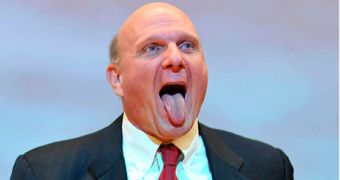Everybody knows that Steve Ballmer will soon leave Microsoft after 33 years within the company, with the Redmond giant still searching for the right person to head its business and ensure long-term profitability.
Little was said on the reasons behind Steve Ballmer’s decision to retire, but some people familiar with the matter hinted that the CEO was actually asked to go by the company’s shareholders, who were a little bit disappointed with the direction Microsoft was going.
It turns out that this wasn’t true, as Ballmer himself decided to spill the beans in an interview with the Wall Street Journal that’s full of nostalgic and sentimental moments.
Steve Ballmer admits that “as much as I love everything about what I’m doing, the best way for Microsoft to enter a new era is a new leader who will accelerate change.”
“Maybe I’m an emblem of an older era, and I have to move on,” he adds.
But the decision to leave Microsoft was made in May on a London street. Walking around for a few minutes and contemplating about Microsoft, Ballmer started thinking that the Redmond-based giant would do better without him, with the change he started likely to take place faster with a new leader.
Ballmer reckons that it was hard to write a retirement letter. There were maybe 40 drafts before actually understanding that it was the time to leave Microsoft.
In late May, on a plane returning to the US from Europe, Ballmer told Microsoft General Counsel Brad Smith that “it might be the time for me to go.” It was the first time he said this to someone else.
The next day, he said the same thing to Lead Director John Thomson, who’s now the head of a commission in charge of finding a new CEO. From that point on, it was pretty clear that Microsoft was paving the road for a brand new era for the company.
Bill Gates, one of his closest friends, told Ballmer that he knew how hard it is to leave Microsoft when the company was his life, but he decided to support the decision as long as the company remains successful.
Later that day, Ballmer told his wife and three sons that he decided to leave Microsoft. They all burst into tears.
As far as his successor is concerned, Ballmer has no pick, although he reckons that Mulally is one of his best friends. In fact, Ford’s CEO Alan Mulally, a turnaround man for the American carmarker, has helped Ballmer bring the One Microsoft transformation plan to reality.
The two met on Christmas Eve at a Starbucks near Seattle, with the outgoing CEO asking for advice on how to start Microsoft’s corporate overhaul. Mulally detailed how he managed to transform Ford into a profitable business for no less than four hours, explaining that simplifying the brand and putting the focus on teamwork was essential.
That’s what Ballmer is now trying to do. Instead of promoting competition between workers, he’s recommending them to work closer together. At the same time, he now calls all Microsoft’s unit heads in the same office to discuss the way the company goes.
He’s no longer interested in lengthy reports and he only wants short and simple ideas on how to get things done. Qi Lu, Microsoft’s executive vice president and one of those initially in the race for the CEO seat, admits he was surprised to see that Ballmer didn’t want to read his 56-page report. He only wanted 3 pages, he noted.
In the end, Ballmer will be leaving Microsoft as soon as a successor is found. Maybe he wasn’t the best CEO, but he undoubtedly is a true Microsoft man. And the message he sent to company executives at one of his latest meetings pretty much speaks for itself.
“Please take good care of Microsoft.”

 14 DAY TRIAL //
14 DAY TRIAL //